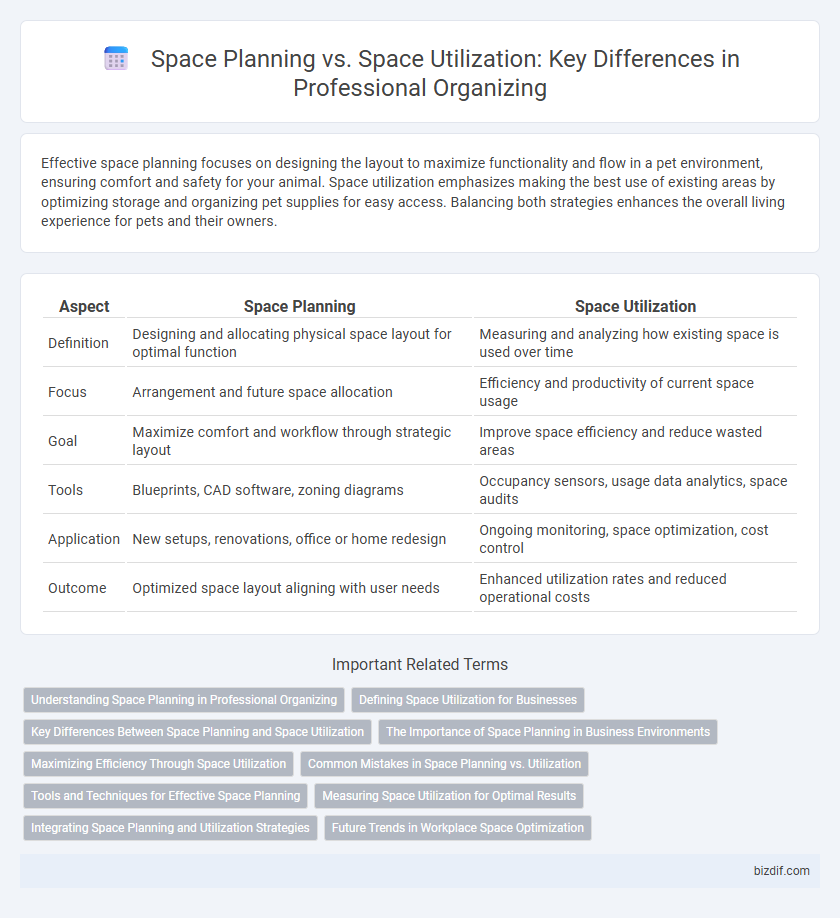Effective space planning focuses on designing the layout to maximize functionality and flow in a pet environment, ensuring comfort and safety for your animal. Space utilization emphasizes making the best use of existing areas by optimizing storage and organizing pet supplies for easy access. Balancing both strategies enhances the overall living experience for pets and their owners.
Table of Comparison
| Aspect | Space Planning | Space Utilization |
|---|---|---|
| Definition | Designing and allocating physical space layout for optimal function | Measuring and analyzing how existing space is used over time |
| Focus | Arrangement and future space allocation | Efficiency and productivity of current space usage |
| Goal | Maximize comfort and workflow through strategic layout | Improve space efficiency and reduce wasted areas |
| Tools | Blueprints, CAD software, zoning diagrams | Occupancy sensors, usage data analytics, space audits |
| Application | New setups, renovations, office or home redesign | Ongoing monitoring, space optimization, cost control |
| Outcome | Optimized space layout aligning with user needs | Enhanced utilization rates and reduced operational costs |
Understanding Space Planning in Professional Organizing
Space planning in professional organizing involves strategically arranging furniture and storage solutions to maximize both functionality and flow within a room. It prioritizes the optimal layout to enhance movement, accessibility, and visual appeal, differing from space utilization which focuses on the efficient use of storage capacity. Understanding space planning allows organizers to create environments that promote productivity and comfort while minimizing clutter.
Defining Space Utilization for Businesses
Space utilization for businesses refers to the efficient allocation and use of physical areas to maximize productivity and cost-effectiveness. It involves analyzing how workspaces are occupied, identifying underutilized areas, and implementing strategies to enhance functionality without expanding square footage. Effective space utilization directly impacts operational efficiency, employee satisfaction, and overall business performance.
Key Differences Between Space Planning and Space Utilization
Space planning involves the strategic arrangement of furniture and fixtures to optimize the functionality and flow within a room or building layout. Space utilization measures the efficiency of the available space by analyzing how well the area is used for its intended purpose, often focusing on minimizing wasted or underused areas. The key difference lies in space planning being a design process targeting optimal spatial layout, while space utilization assesses the practicality and effectiveness of that layout in everyday use.
The Importance of Space Planning in Business Environments
Effective space planning in business environments maximizes operational efficiency by strategically arranging workspaces to enhance workflow, collaboration, and productivity. Prioritizing space planning over mere space utilization ensures that every square foot supports business objectives and employee comfort, reducing clutter and optimizing resource allocation. Integrating ergonomic design and future expansion potential into space planning directly impacts employee satisfaction and overall organizational performance.
Maximizing Efficiency Through Space Utilization
Maximizing efficiency through space utilization involves analyzing the function and flow of a room to ensure every square foot serves a purpose, reducing wasted areas and enhancing accessibility. Unlike space planning, which focuses on the initial layout design, space utilization prioritizes optimizing existing arrangements to improve functionality and productivity. Effective space utilization techniques include multi-purpose furniture, vertical storage solutions, and strategic placement to facilitate ease of movement and task completion.
Common Mistakes in Space Planning vs. Utilization
Common mistakes in space planning versus utilization often include overestimating available square footage and underestimating storage needs, leading to inefficient layouts. Ignoring traffic flow and ergonomic design can cause clutter and restrict movement, reducing overall functionality. Proper assessment of both physical dimensions and user habits is critical to optimize space use and avoid costly redesigns.
Tools and Techniques for Effective Space Planning
Effective space planning relies on tools such as CAD software, 3D modeling, and digital floor plans to visualize and optimize room layouts. Techniques like zoning, measuring traffic flow, and selecting multifunctional furniture enhance spatial efficiency and usability. Incorporating modular storage systems and adjustable shelving supports adaptability for various organizational needs.
Measuring Space Utilization for Optimal Results
Measuring space utilization involves analyzing the actual use of available areas to ensure optimal efficiency in professional organizing projects. Key metrics include occupancy rates, frequency of use, and traffic flow patterns that reveal underused or congested zones. Accurate data-driven assessments enable tailored space planning solutions that maximize functionality and enhance user experience.
Integrating Space Planning and Utilization Strategies
Integrating space planning and utilization strategies maximizes efficiency by aligning layout design with actual usage patterns in professional organizing. This approach ensures optimal allocation of storage solutions while enhancing accessibility and flow within spaces. Leveraging data on space utilization informs dynamic planning, resulting in tailored environments that support productivity and decluttered living.
Future Trends in Workplace Space Optimization
Future trends in workplace space optimization emphasize a shift from traditional space planning to dynamic space utilization, leveraging real-time data and AI-driven analytics to enhance flexibility and employee productivity. Integration of IoT sensors allows organizations to monitor space usage patterns, enabling adaptive layouts that respond to evolving collaboration needs and hybrid work models. Embracing these innovations promotes sustainable office environments that maximize resource efficiency and support well-being.
space planning vs space utilization Infographic

 bizdif.com
bizdif.com